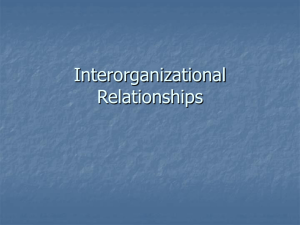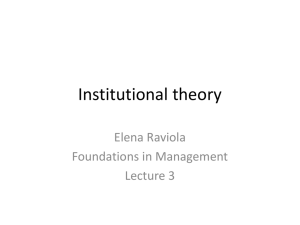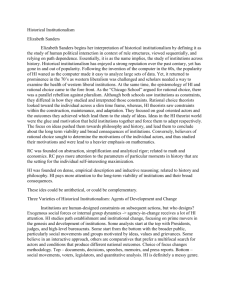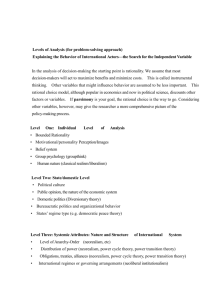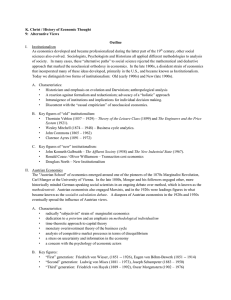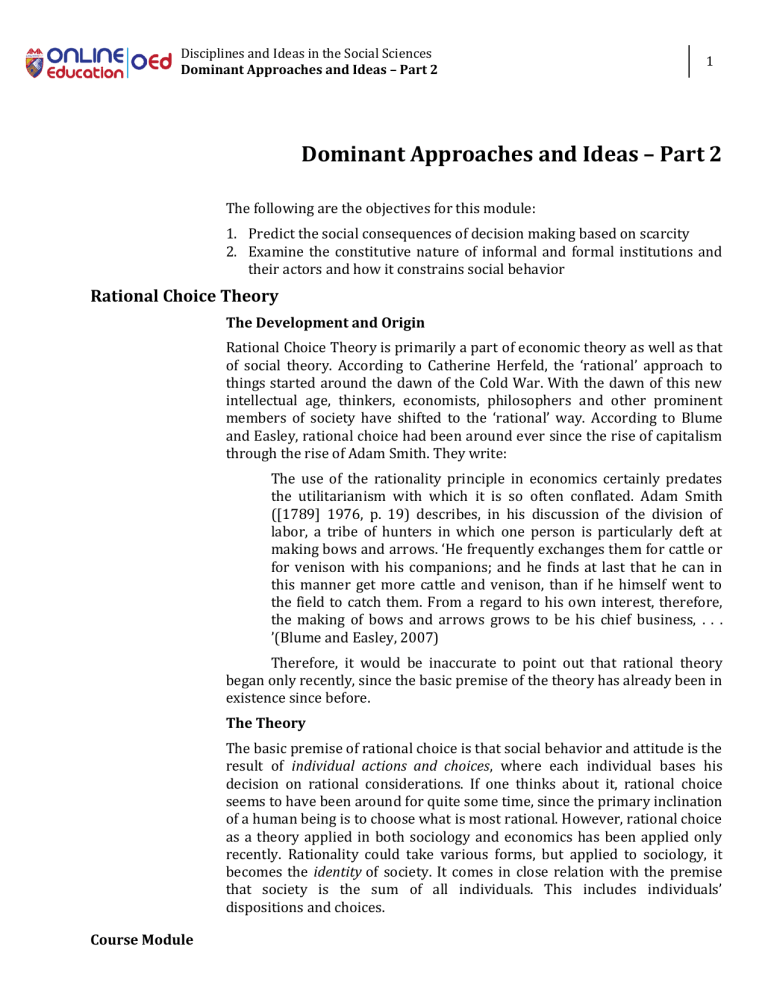
Disciplines and Ideas in the Social Sciences Dominant Approaches and Ideas – Part 2 1 Dominant Approaches and Ideas – Part 2 The following are the objectives for this module: 1. Predict the social consequences of decision making based on scarcity 2. Examine the constitutive nature of informal and formal institutions and their actors and how it constrains social behavior Rational Choice Theory The Development and Origin Rational Choice Theory is primarily a part of economic theory as well as that of social theory. According to Catherine (erfeld, the rational approach to things started around the dawn of the Cold War. With the dawn of this new intellectual age, thinkers, economists, philosophers and other prominent members of society have shifted to the rational way. According to Blume and Easley, rational choice had been around ever since the rise of capitalism through the rise of Adam Smith. They write: The use of the rationality principle in economics certainly predates the utilitarianism with which it is so often conflated. Adam Smith ([1789] 1976, p. 19) describes, in his discussion of the division of labor, a tribe of hunters in which one person is particularly deft at making bows and arrows. (e frequently exchanges them for cattle or for venison with his companions; and he finds at last that he can in this manner get more cattle and venison, than if he himself went to the field to catch them. From a regard to his own interest, therefore, the making of bows and arrows grows to be his chief business, . . . (Blume and Easley, 2007) Therefore, it would be inaccurate to point out that rational theory began only recently, since the basic premise of the theory has already been in existence since before. The Theory The basic premise of rational choice is that social behavior and attitude is the result of individual actions and choices, where each individual bases his decision on rational considerations. If one thinks about it, rational choice seems to have been around for quite some time, since the primary inclination of a human being is to choose what is most rational. However, rational choice as a theory applied in both sociology and economics has been applied only recently. Rationality could take various forms, but applied to sociology, it becomes the identity of society. It comes in close relation with the premise that society is the sum of all individuals. This includes individuals dispositions and choices. Course Module Institutionalism The Development and Origin Institutionalism as a theory is very broad, since it covers a number of subtopics that deal with different aspects of society. Their one similarity is that all of these sub-topics deal with the function and relevance of institutions. As a theory, it comes from the establishment of organizations throughout history that led to the creation of what we call an institution. Examples of institutions are schools, hospitals, correctional facilities and many other sectors of society. All of these sectors originate from the gradual establishment of a structured body that governs over a certain point in society. Key Thinker: Michel Foucault One of the major thinkers when it comes to the study of institutional theory is the French philosopher and sociologist Michel Foucault. His works include Discipline and Punish, The Birth of the Clinic, History of Sexuality and other works that deal with the function and administration of various institutions over society. For example, the work Discipline and Punish deals with the institution of the correctional facility where he mentions that institutions are instruments of power and that established institutions determine largely the entire character of society. For Foucault, the purpose of institutions would be to create docile and obedient bodies or citizens, thereby making society a subject of the power of institutional forces. The Theory There are three important kinds of institutionalism: (1) Old Institutionalism (2) New Institutionalism (3) Historical Institutionalism According to William Richard Scott: Institutions are social structures that have attained a high degree of resilience. [They] are composed of cultural-cognitive, normative, and regulative elements that, together with associated activities and resources, provide stability and meaning to social life. Institutions are transmitted by various types of carriers, including symbolic systems, relational systems, routines, and artifacts. Institutions operate at different levels of jurisdiction, from the world system to localized interpersonal relationships. Institutions by definition connote stability but are subject to change processes, both incremental and discontinuous. (Scott, 1995) Differentiating between old and new institutionalism can be known through their individual focus. Old institutionalism focuses on the effects of institutions, as well as general rules, schemes, and factors, on the scale of the global or local economy. (Scott, 2008) This refers to the adaptation of businesses to the whims of the local institutions such as the political body, schools, etc. When talking about new institutionalism, this focuses on the sociological view on institutions, the way these institutions co-operate with Disciplines and Ideas in the Social Sciences Dominant Approaches and Ideas – Part 2 3 each other and how they affect society as a whole. (DiMaggio and Powell, 1 This is what we call the social powers that influence the flow and daily living of society. Take for example the institution of the political body. Lawmakers and enforcers have significant contributions to the functioning of society for, without this institution, society would fall short on the need for peace and order. On the other hand, without the institution of the school, the members of a society would be inadequately educated, and would lead to negative effects when it comes to the over-all well-being of society. Thus new institutionalism seeks to understand further how these institutions could shape the value of life a society has. On the other hand, when one speaks of historical institutionalism, it traces the progress of both socio-economic behavior in society through the growth and history of an institution. According to Charles Tilly, historical institutionalism is a method apt for measuring big structures, large processes, and making huge comparisons. Tilly, 1 The value of historical institutionalism is that it shows how an institution can reflect the changes within society, and how one need not to extensively pursue a conclusion based on multiple observations on society, but rather can be focused on one body that sufficiently accounts for a proper description of society s progress. That is why historical institutionalism can be regarded as a combination of both old and new institutionalisms. Glossary Course Module Historical Institutionalism – it traces the progress of both socioeconomic behaviors in society through the growth and history of an institution. Institutionalism – an approach that views institutions as humanly devised constraints that structure political, economic, and social interactions. New Institutionalism – focuses on the sociological view on institutions, the way these institutions co-operate with each other and how they affect society as a whole. (DiMaggio and Powell, 1983) Old Institutionalism – focuses on the effects of institutions, as well as general rules, schemes, and factors, on the scale of the global or local economy. (Scott, 2008) Rational Choice – is a product of scarcity and demand the people to make the right and rational choice to maximize the use of its resources. The basic premise of rational choice is that social behavior and attitude is the result of individual actions and choices, where each individual bases his decision on rational considerations. References Allingham, Michael (2002). Choice Theory: A Very Short Introduction. Oxford: Oxford University Press. Amadae, S.M. (2003). Rationalizing Capitalist Democracy: The Cold War Origins of Rational Choice Liberalism. Chicago: University of Chicago Press. DiMaggio, Paul J. and Powell, Walter W. (1991) )ntroduction . )n P. J. DiMaggio and W. Powell eds. The New Institutionalism and Organizational Analysis , pp. 1–38. Chicago: University of Chicago Press. Meyer, Heinz-Dieter and Brian Rowan (2006) The New Institutionalism in Education. Albany, NY: SUNY Press. Scott, W. Richard (2008) Institutions and Organizations: Ideas and Interests. Los Angeles, CA: Sage Publications. Tilly, Charles (1984) Big Structures, Large Processes, Huge Comparisons. New York: Russell Sage Foundations.
